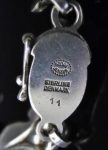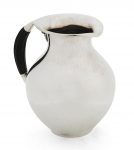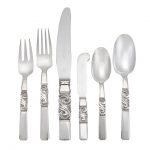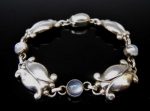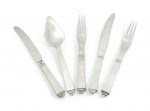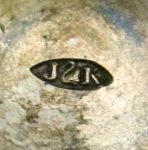Georg Arthur Jensen was a silversmith and founder of the company Georg Jensen. He was apprenticed as a goldsmith until 1884; later he studied sculpture. Trained as a silversmith from 1892-4 in Copenhagen, then worked for Morgens Ballin. The influence of Ballin’s fleshy and organic interpretation of Art Nouveau is evident in Jensen’s work. After the establishment of his own workshop in 1904, he gained renown with an exhibition of silver jewellery. Reference: The British Museum.
Georg Jensen Silver Makers Mark
GEORG JENSEN: A Danish silver pitcher design 385A, 1933 – 1944 period mark, designed by Johan Rohde in 1923 Baluster form, curved fluted wood handle, with trailing berries below the upper junction, height 17.5cm, weight total 16.8oz.
Sold for £ 1,375 inc. premium at Bonhams in 2018
Brooch; silver; hand-raised, hollow-backed, with foliate and bud design, set with central amber stone, the pendant set with a further amber bead; contained in the original leather case with paper label on top.
© The Trustees of the British Museum
A PAIR OF DANISH SILVER COMPOTES, NO. 263 MARK OF GEORG JENSEN, COPENHAGEN, 1918 Grapevine pattern, designed by Georg Jensen in 1918, marked and dated to underside 7 ½ in. (19 cm.) high, 33 oz. 5 dwt. (950 gr.)
Sold for USD 2,500 at Christies in 2018
Georg Jensen Sterling Silver Scroll Pattern Flatware Service Comprising twelve dinner forks, twelve salad forks, twelve dinner knives, twelve butter knives, twelve dessert spoons and twelve teaspoons. Total approximately 95 ounces, weighable.
Sold for $5,000 (includes buyer’s premium) at Doyle New York in 2018
Vintage sterling silver link bracelet set with cabochon moonstone. Bracelet signed “GEORG JENSEN DENMARK 11” Bracelet is “Moonlight Blossom” designed and produced by Georg Jensen (Denmark 1866-1935). Total weight: .51 Ozt
Sold for $700 at J. James Auctioneers & Appraisers in 2018
Georg Jensen was born in 1866. He was the son of a knife grinder in a town north of Copenhagen called Raadvad. He started training at the age of 14 and was apprenticed to Guldsmet Andersen until 1884. Georg Jensen’s main ambition was to be a sculptor and studied this at the Royal Academy of Fine Arts until he graduated in 1892 and began exhibiting his work. At this stage it was mainly clay sculpture but he found it difficult to make a living in this field. He went on to become a modeller at the Bing & Grondahl porcelain factory then in 1898 he founded a partnership with Christian Petersen. This still proved difficult so in 1901 went back to being a silversmith and designer with Mogens Ballin. In1904 he opened his own silversmith company at 36 Bredegade, Copenhagen. This allowed him to combine his training in metalwork to form unique pieces of silver. He is most famous for Art Nouveau work and became extremely successful. By the late 1920’s there were retail outlets in London, Paris, New York, Stockholm, Berlin and Buenos Aires. Although Georg Jensen died in 1935 the company is still in existence today.
‘Sydney Opera House’ earrings by Georg Jensen Made by Georg Jensen Company in Denmark, Europe, 1987-1998. The ‘Opera House Earrings’ no. 379, which were designed and made by Regitze Overgaard for the Georg Jensen company in Denmark, are among the rarer of her designs. While the fan-like design was originally intended to reflect modernist principles, it has since become Australiana due to its resemblance to the Sydney Opera House. While the inspiration for the earrings did not come from the Opera House, their distinctive design resolution invited later comparison with Australia’s most iconic building and the current ‘title’ as well as creating a new meaning. These earrings are a fine example of Overgaard’s strong conviction that jewellery designs should be simple. This design is rarely found today and the earrings’ resemblance to an Australian icon makes them unique in the context of Scandinavia jewellery design.
Reference: Museum of Applied Art and Sciences
Danish silver ‘Pyramid’ pattern flatware, Georg Jensen, Copenhagen, 1925-31 comprising: six fruit knives, six fruit forks, six fruit spoons, with four further fruit knives and forks (26) 847gr., 27oz. 4dwt.
Sold for 1,500 GBP at Sothebys in 2018
